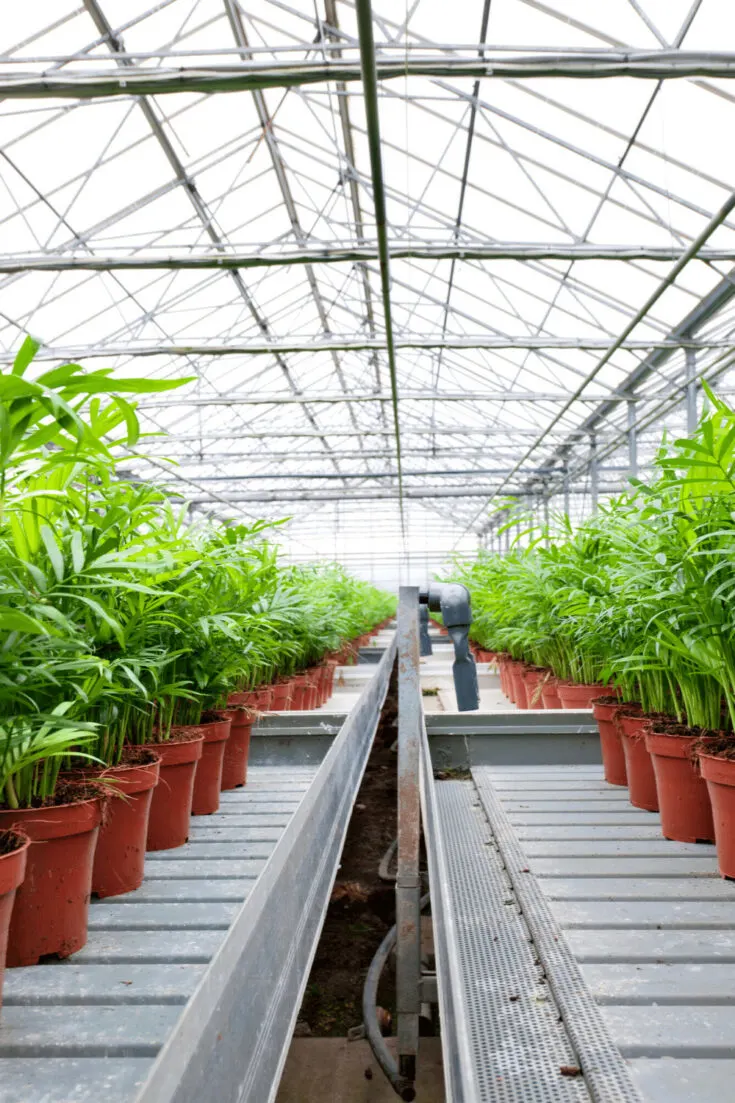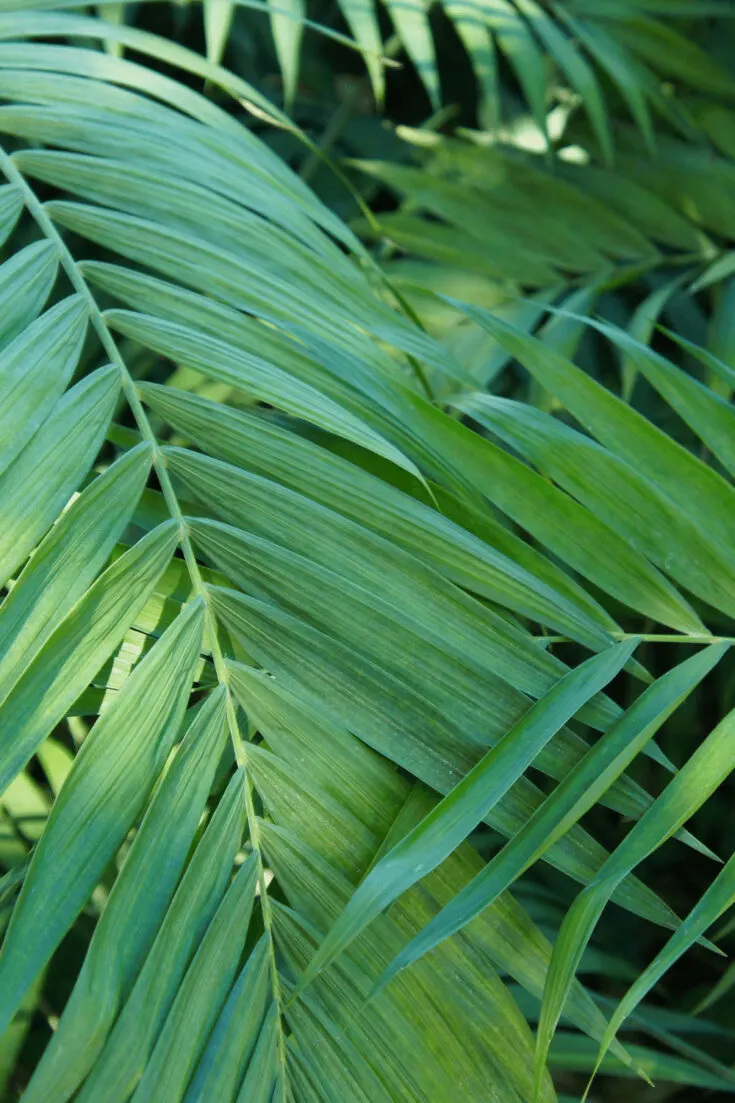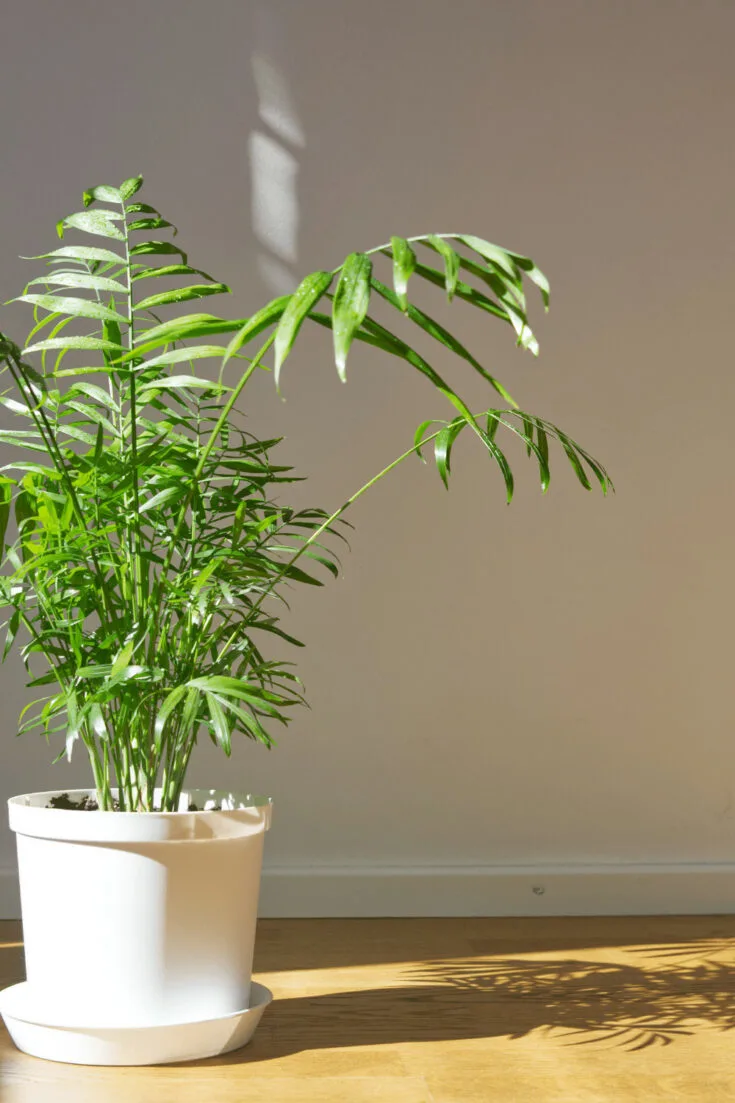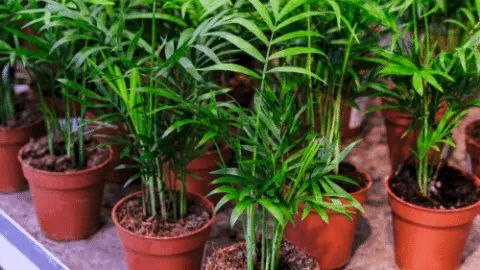The Neanthe Bella Palm or Parlor Palm is among the world’s most widely distributed palms. It is a famous variety of leaf-harvested species.
This plant has even won the Royal Horticultural Society’s Award of Garden Merit, proving its worth in indoor gardens.
Neanthe Bella Palm Care
To care for Neanthe Bella Palm, provide bright indirect light, slightly moist soil, and water every 7-10 days. Fertilize once a month in spring and summer using organic fertilizer and a peat-based soil mix. The ideal temperature is between 65-80 degrees Fahrenheit (18-27 degrees Celsius) and a humidity of 60% or more.

Neanthe Bella Palm Care
Table of Contents
Neanthe Bella Palm Plant Care Guide
The Neanthe Bella Palm (Chamaedorea Elegans), or Parlor Palm, originating from Southern Mexico and Guatemala’s tropical rainforests, is recognized for its air purification qualities.
Neanthe Bella Palm is a woody, rhizomatous plant with a slender green trunk. It is grown as a houseplant in temperate areas and in gardens in the Southeastern United States. The house plant belongs to the family of Arecaceae and the genus Chamaedorea.
A notable aspect of this species is the premature age for flowering, with some plants flowering at a height of barely 11 inches (30 cm).
This plant is always in high demand due to its adaptability to average indoor climates.
Soil
You can cultivate Neanthe Bella Palms indoors in a peaty, soil-based potting mix. Outdoors, Neanthe Bella Palms, grows best in sand, loam, and clay. It does not like salty soils.
Neanthe Bella Palm requires well-draining soil, indicating it does not appreciate soaking or flooding at any period.
It is fairly drought-tolerant but grows best in uniformly moist soil throughout the spring and summer growing seasons.
Neanthe Bella Palm needs acidic or neutral soils with a pH between 5.1 and 7.5. In alkaline soils, this plant might indicate signs of nutrient insufficiency, such as yellowing of the foliage.
In a high pH, the Neanthe Bella Palms cannot effortlessly use the iron and manganese in the soil, and magnesium will also leach rapidly.
These ingredients are all vital to the well-being of the Palm. It is best to keep the pH below 7.0.
Water
Underwatering a Neanthe Bella Palm is safer than overwatering. Water properly, then wait until an inch beneath the soil surface has dried up (2.5cm), at which moment water well again. This tolerant plant will let you off if you forget to water on time.
Make sure you restrict the volume of water given when light or temperature is at a low level because, in those circumstances, plants don’t need as much water.
Too much water around the roots for extended intervals will promote fungi and run the risk of root rot, which could instantly kill your plant.
To prevent this from happening, all you should do is make sure no water is being kept in the drip container or in the container surrounding it after you’ve watered it. If there is, drain it in the sink.
Light
Neanthe Bella Palm prospers in various indoor lighting settings, but an area with medium to bright light and a north or west-facing window is best.
Neanthe Bella Palm grows dark green leaves in low light and can be preserved very well with lighting you’ll get in nearly all offices or houses.
Whenever you put a Neanthe Bella Palm in intermediate light, please don’t put it in the afternoon sun.
The morning sun or bright filtered light is suitable, but the afternoon sun can bleach out the foliage. These small palm trees cannot withstand contact with direct, harsh sunlight.
This Palm can also grow in full to partial shade. While it is easygoing in lower-light environments, you may observe leggy growth.
So choose a place where it will receive bright indirect light a few feet from a southern, western, or eastern-facing window.

Provide bright indirect light for a Neanthe Bella Palm.
Temperature
The Neanthe Bella Palm favors room temperatures between 65 and 80 degrees Fahrenheit (18-27 degrees Celsius).
It can stand a low temperature of about 50 degrees Fahrenheit (10 degrees Celsius) but will die if kept in cold temperature for too long. Keep it away from cold breezes near windows, vents, and outside doors.
It will grow well with average temperature and humidity. But if it starts developing dry leaf edges or brown tips, the most obvious cause is cold drafts or extended dry periods. To fix this condition, increase the temperature and give more water to your plant.

The ideal temperature for Neanthe Bella Palm is 65 and 80 degrees Fahrenheit (18-27 degrees Celsius)
Humidity
Neanthe Bella Palm prefers a humidity of 60% or more.
In the natural environment of thick rainforests, the humidity levels are elevated and persistent.
Hence, your Neanthe Bella Palm thrives and looks its best with these settings.
If humidity is too low, the Palm can develop brown tips on the fronds. You can easily imitate the natural climate using different techniques.
Use a humidifier to raise humidity levels for your Neanthe Bella Palm. Or put the container on a tray of pebbles.
As you water, the water drains from the bottom side of the pot’s holes and into the pebble-lined platter, and as this water evaporates, it produces humidity around the plant.
If your bathroom has sufficient light and is big enough, depending on your Neanthe Bella Palm size, you can cultivate the plant in the bathroom.
Due to the continuous utilization of water inside the room, sufficient humidity is available for your plant.

Provide Neanthe Bella Palm with 60% humidity or more.
Fertilizer
Neanthe Bella Palm is comparatively small and doesn’t want a huge quantity of feed to do well. A conventional feed once every month will be sufficient for mature plants. Younger plants will be delighted with somewhat more, so aim for once a month.
Combining 2 to 3 inches of organic compost (5-7.5cm) or well-composted fertilizer before planting will offer nutrients for the Palm for the initial months.
Neanthe Bella Palm will flourish on a slow-release fertilizer in the second growing season.
Apply a couple of tablespoons of a slow-release 8-2-12 palm fertilizer in early spring to give it the necessary nutrients. Mix the fertilizer into the soil; do not let the fertilizer contact the foliage.
Repotting
Neanthe Bella Palm generally doesn’t like frequent root disturbance, and since they have weak root structures, regular repotting can be destructive over the long term.
Despite this threat, young plants will often want to be repotted once a year until they become mature because they need room to expand.
Repot older plants only when the potting soil is too compacted and begins to disturb your watering attempts.
Because the water continuously drains out, causing the soil to dry, or it becomes like a sponge and ends in a soggy mess. Convincingly a mature plant is repotted every two or three years.
You can use the typical everyday manure from the garden center for repotting. A container one size larger is a nice plan, but if you wish, you can leave the plant in the old container after refreshing the soil mix.
When you put the Neanthe Bella Palm in the new container, secure it in a spot by packing it fairly tightly around the root ball.
Pruning
As Neanthe Bella Palm do not grow very high, pruning is typically not suggested. But if there are yellow or brown fronds, feel free to trim those. Pruning the dead leaves that died naturally is also safe.
These slow-growers will halt growing completely if they are over-pruned.
Use gloves and protective goggles while pruning to stay safe from plant-related allergies.
Use sharp and disinfected pruning shears or blades. For disinfecting, use a mixture of bleach and water, or you can also use rubbing alcohol. Always clean the plant’s surroundings to protect it from diseases and pests.
Propagation
If you do intend to try it at home, division—while not guaranteed—is a simpler option for turning one Neanthe Bella Palms into two plants.
It is feasible to propagate your Neanthe Bella Palms by splitting one of the clusters of stems in your existing plant.
You might see some dieback of foliage on both the new and parent plant, which can be cut away from the healthy leaves. Start with a Neanthe Bella Palms that is thriving in its container with has several healthy stems.
- Select a container that’s a suitable size to keep a single stem from the mother plant. Fill it up with a soilless mix of equivalent parts, peat moss and either vermiculite or perlite.
- Carefully take out the mother plant from its container.
- You should loosen the potting soil around the root ball to reveal its bare roots.
- See for a healthy-looking stem with its root structure. Gently cut away any roots linking it to the main plant with a clean, sharp blade.
- Plant your fresh stem in the container with the soilless mix, confirming that the roots and the stems are protected by the soil. Set the mother plant back into its previous container, filling it out with fresh soil.
- Water so that the potting soil is moist and humid. Keep both the parent and new plants in a warm, shady position to recover, then care for them as usual.

Propagate Neanthe Bella Palm by division
Blooms
Often this plant produces small flowers and tiny seeds during the year. These blooms appear on a grown, well-groomed, and well-cared plant. The flowers grow below or between the fronds and vary in yellow, orange, or red hues. They form a cluster of tiny balls without petals.
This plant is not famous for its flowers because they don’t have a strong scent or a stunning appearance.
Growth
Neanthe Bella Palms is grown mainly for indoor use in 6 – 14 inch containers, varying in sizes from 3-4 feet (0.9-1.2m) tall. With proper plant care, this variety can reach 6 to 8 feet (1.8 – 2.4m) in height.
This Palm has an upright and spreading growth. The leaves of this variety are thin and long compared to other Palms.
Each cluster of leaves grows from a thick, fleshy petiole. The long fronds are about 6 inches (15.24) in length and 1 inch (2.5 cm) in width.
The bamboo-like stems are ¾ inches in diameter, each with 12 or more pairs of leaflets. Neanthe Bella Palms is winter hardy in USDA hardiness zones 10 through 12.
Common Problems for the Neanthe Bella Palm
There are a few problems that may occur with improper water and light. An overly dry Neanthe Bella Palms can attract bugs, and soggy roots can lead to disease. Here is a list of possible pests and diseases:
Pests
If your house is overly warm and dry, this may promote a population of spider mites; if you notice little webs on the bottom of the leaves, you’ve got an invasion.
Neem oil and insecticidal soap can help in their destruction. Change the indoor conditions of your house to make it more friendly to the Palm and less to the bugs.
Scale insects can also infect indoor Palm plants. There are around 8,000 species of scale that mainly all build up some sort of waxy defense covering.
The soft scale will leave honeydew, causing moldy fungus on the plant. Wilted and yellowing leaves are major signs of their existence.
Physically eliminating them is the easiest method of management for a small population. Aim to get hold of the little bugs at their crawling stage, where they are more vulnerable. Insecticidal sprays are an alternative option.
Mealybugs form mass groups on the Neanthe Bella Palms leaves. Like spider mites, mealybugs remove the plant’s juices, discoloring foliage. The smaller the Neanthe Bella Palms, the more damage the pest causes.
Remove the affected foliage with a fresh, damp cloth in minor infestations. Spray both sides of the foliage and plant with insecticidal soap or Neem. Reapply to destroy the mealybugs completely.
Root Rot
This deteriorating disease has indicators similar to other diseases and pest problems, which include weak growth, faded leaves, early leaf decline, branch dieback, and eventual death.
It occurs most frequently in damp soil. There is no proper cure for a root or stem rot; therefore, avoid getting this disease by controlling watering. Make sure that the Neanthe Bella Palm resides in well-draining soil.
Cankers
Several causes can be detected for this problem, involving bacteria, frost, or fungi.
An infected lesion in the Neanthe Bella Palms plant can halt the upward movement of essential nutrients to the rest of the plant’s sections. Fundamental plant care is typically sufficient to prevent cankers from happening.
Leaf Spot
This is a fungal or bacterial source of mole-like spots that can combine into bigger blights on the leaves. If left untreated, it can harm the foliage.
Eliminate the diseased leaves and increase airflow for the rest of the plant. You should also avoid overhead watering to prevent fungus growth. A regular application of fungicide can benefit as well.
Tips for Growing Neanthe Bella Palms
- Neanthe Bella Palm doesn’t need to be pruned—pruning can harm your plant. Only cut back leaves that have died naturally.
- Provide your Neanthe Bella Palm with bright indirect sunlight to help them grow happy and healthy. The perfect spot for this is an east or west-facing window.
- Overwatering can damage your Neanthe Bella Palm, leading to many problems for your plant, so it better provide it with sufficient water.
Frequently Asked Questions about the Neanthe Bella Palm
How much light do Neanthe Bella Palms need?
One of the great characteristics of the Neanthe Bella Palm is its capability to prosper in lower-light environments and artificial lighting. It keeps expanding in a lower light setting, where many indoor plants fail to thrive.
Does a Neanthe Bella Palms produce seeds?
Although indoor Neanthe Bella Palms rarely bloom to produce fruit, in their preferred environment, the Neanthe Bella Palms produce yellow flowers that turn into small black fruits that contain a seed per fruit.
Are Neanthe Bella Palms toxic to cats?
Neanthe Bella Palms are considered non-toxic to cats, dogs, and people. Hence you don’t have to be concerned about your animal being around it. They are a pet-friendly plant breed.
How tall do Neanthe Bella Palms get?
Neanthe Bella Palms grown indoors typically grow 4 feet (1.2 m) tall, but when grown outdoors in a preferred environment, the Neanthe Bella Palms can reach 8 feet (2.4 m) tall at maturity.
Conclusion
The Neanthe Bella Palms have been trendy indoor plants ever since Victorian times, and today, they still maintain their reputation.
Besides, within the home, you can frequently see these attractive palms growing in office buildings, schools, and shopping centers. These are gorgeous, lush palms, and it is simple to see why they are so widespread.
The Neanthe Bella Palms has elegant, green leaflets on arching fronds, giving this Palm a soft canopy structure.
With sufficient light and temperature, a mature plant may generate several tiny, yellow flowers on large stalks above the foliage.
The flowers are supported by seeds that are hardly fertile and not worth conserving, so just cut off the flowers when they start to turn brown.
Follow the instructions in this article to you enjoy this tropical beauty.

Daniel has been a plant enthusiast for over 20 years. He owns hundreds of houseplants and prepares for the chili growing seasons yearly with great anticipation. His favorite plants are plant species in the Araceae family, such as Monstera, Philodendron, and Anthurium. He also loves gardening and is growing hot peppers, tomatoes, and many more vegetables.


